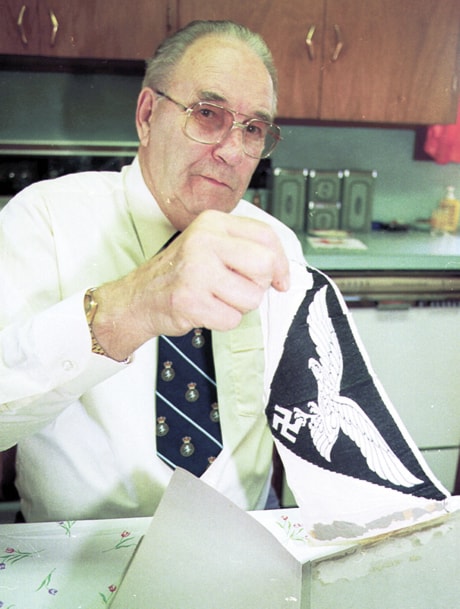When Robert Henry Hill of Lacombe died in 2002, he left behind a chronicle of his experiences as a captured soldier during the Second World War.
And now that huge journal, and the piece of history it represents, has been rescued from the City of Red Deer landfill.
“It’s basically rescued history that would have been lost forever . . . the names of the individuals in the photos we’ll be able to cross-reference with other photos and identify previously unknown people now,” said Rory Cory, senior curator at the Military Museums in Calgary.
In March, Cade Graville, a 28-year-old roofer from Sylvan Lake, was dumping refuse from a job he had just completed in Red Deer at the city’s landfill. A cardboard box marked “R.H. Hill,” its contents spilled out into a dumpster, caught his eye.
“I have a keen eye for army green, and when I saw an army badge and I recognized the chevron, I jumped right in (the dumpster),” said Graville, who comes from a military family and served with the Canadian Forces.
Graville scooped the war medals, framed pictures and newspaper clippings back into the box, and said he knew when he picked up a thick, leather-bound journal that he had something special in his hands.
“I thought about keeping it but it’s just too big of a find not to share, I think I made the right decision,” Graville said.
The journal details Hill’s 33-month imprisonment at Stalag VIII-B, a notorious German PoW camp located in Poland during the Second World War, after the disastrous Dieppe raid on Aug. 19, 1942, in Northern France.
“Each of these scrapbooks are unique, one-of-a-kind objects of the experiences of a World War II prisoner,” said Cory.
Graville took the rescued artifacts to the Military Museums last week, and Hill’s journal is now on display in the main atrium of the King’s Own Calgary Regiment Museum (formerly the Calgary Tanks Regiment, which Hill was enlisted under during the war).
Cory said Hill’s journal is one of several in the Military Museums’ possession, but the detailed information (particularly the captioned photos and prison camp money) inside makes Hill’s account an incredibly rare find.
The journal was provided by the YMCA to Hill during his internment at Stalag VIII-B. Cory said it was common for Allied PoWs to be allowed care packages (consisting of food, cigarettes, writing materials, even sporting goods) from the Red Cross, YMCA and other Canadian charities while they lived under Nazi imprisonment.
A framed, May 1992 Advocate article, found in the dumpster along with his journal, reported on Hill (then 77), getting set to travel to Dieppe to mark the 50th anniversary of the invasion. He recounted his harrowing story of prison camp survival. For nearly three years, the captured tank driver lived on bread, turnips, potatoes, hard cheese and “the odd chunk of horse meat.” Hill credited weekly Red Cross packages of margarine, jam, powdered milk, biscuits, corned beef and chocolate with helping keep him alive.
Starting in October 1942, he was one of 1,800 prisoners chained for 12 hours a day and denied their Red Cross packages for the next 13 months. The Germans were retaliating to the news that Nazi PoWs had drowned in the English Channel with their hands bound. The lack of nutrition left him with weak eyesight, and he had to rely on his fellow soldiers to enter information into his log book.
“I don’t know why I keep this stuff really,” Hill said in 1992.
The book has neatly-written lists of soldiers’ names, what they ate, the parcels and cards they received from home, photos and even a German guard’s arm band — taken from a Nazi’s lifeless body.
When asked about a photo in the book that shows Hill and other Canadian soldiers looking tidy and cheerful a full year into their imprisonment, he replied: “You don’t let them know (the German soldiers) you think anything but positively.”
Hill admitted in the 1992 account that he gave himself a 50 per cent chance of returning home alive from Stalag VIII-B.
Of the 4,396 Canadian soldiers involved in the Dieppe raid, 993 were killed, 1,874 were captured, and 586 returned to England wounded. The Allied attempt to test the defences of Adolf Hitler’s continental fortress is considered one of the greatest military disasters in Canadian history. The Allies came under heavy fire from the cliffs above the beach in Northern France.
“It was a terrible experience but also a benchmark moment in Canadian history, and to have this album is important to our history,” said Michael Dawe, curator of history at the Red Deer Museum.
Dawe is familiar with Hill’s story and said one of his only surviving relatives, a step-son, passed away a few years ago. He can’t imagine someone would knowingly throw out such an important piece of Canadian military history.
Neither can the Military Museums curator.
“You’d be surprised, this is the second or third instance we’ve had like this since I started here (four years ago),” Cory said.
“We have another medal set that one of our researchers found in the garbage; people just don’t realize what it is, it looks like a book of newspaper clipping to them, so they throw it out not knowing its historical value.”
As the years pass since the war’s end and more veterans die, it is important that families take stock of historical artifacts in their possession, so the relics get the treatment they deserve, Cory said.
“Hopefully the Second World War generation that is still around is having conversations with their family members now, so they can identify the things that are important to preserve,” Cory said.
“You can write into your will that you’d like certain things preserved in a museum, for long-term storage.”
syoung@www.reddeeradvocate.com
